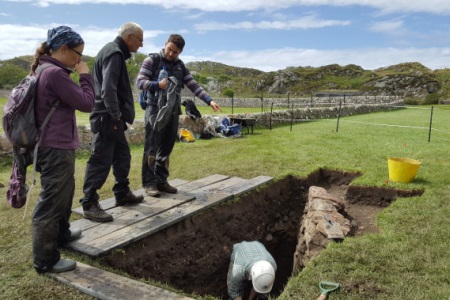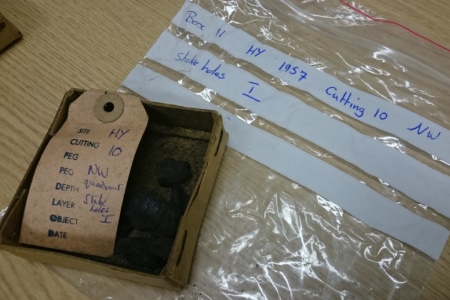St Columba’s Iona ‘hut’ radiocarbon dated
Published: 11 July 2017
Archaeologists from the University of Glasgow have uncovered “conclusive evidence” of a wooden structure, within the monastery on the island of Iona, dating back to the time of St Columba in the late sixth century AD.
Archaeologists from the University of Glasgow have uncovered conclusive radiocarbon evidence of a wooden hut on Iona dating back to the late 6th Century AD, believed to be that of St Columba when he worked at the monastery.

Radiocarbon tests show samples of charcoaled hazel unearthed from a site excavation 60 years ago, where it is believed Columba’s wooden hut was situated, date back to the exact period it is claimed Columba lived and worked at the monastery.
The samples, excavated in 1957 by British archaeologist Professor Charles Thomas, have lain in a garage in Cornwall, preserved in matchboxes, until 2015 when a University of Glasgow team decided to follow up his research.
The charcoal samples have now been radiocarbon dated, and for the first time data shows the burnt wooden remnants correspond with the same period in history when Columba lived and worked in a wooden hut next to the Iona monastery.
St Columba is widely revered as a key figure, who brought Christianity to Scotland from Ireland, landing on Iona in 563 AD.
In the ‘Life of Columba’, written 100 years after his death, a contemporary writing in historical terms, St Columba is depicted as writing in his cell on a rocky hillock within the monastery grounds, looking out his door towards the mountains of Mull.
Commenting on the findings, Dr Adrián Maldonado said: “This discovery is massive. St Columba is a key figure in Western Christendom. He was the national patron saint of Scotland in the Middle Ages.

“We got access to the original finds from Charles Thomas, which are processed by Historic Environment Scotland, and we could work on his notes and charcoal samples which were excavated in 1957. Luckily Charles Thomas kept hold of them, he knew they were important, and because they were kept in a dry, stored in matchboxes, they are still in a good condition.
“Charles Thomas always believed he and his team had uncovered Columba’s original wooden hut, but they could never prove it because the technology wasn’t there. Radiocarbon dating was in its infancy, it had only been discovered a year earlier in 1956, so there was not a lot they could do with the samples.
“So for us, 60 years later, to be able to send the original samples off to the radiocarbon dating labs and have them come back showing, within the margin of error, as something which may have been built in the lifetime of St Columba, is very exciting.”
Professor Charles Thomas excavated the site 60 years ago, when the hazel charcoal samples were unearthed below layers of loose rock, suggesting the wooden structure had burned down and the area filled over.
Until recently the finds from the site were believed to be missing, but a project led by University of Glasgow archaeologists Dr Ewan Campbell and Dr Adrián Maldonado, funded by Historic Environment Scotland, re-located the samples.
Through the services of the Scottish Universities Environmental Research Council (SUERC), the world-leading centre for scientific analysis, they decided to carbon date the hazel stakes and the results show the hut dated back to AD 540-650, Columba died in 597AD.
Although the excavators of the hut had argued it was Columba's cell the lack of dating technology and evidence at the time led many archaeologists to dismiss the findings as speculation and scientifically unproved.
Professor Thomas Clancy, Celtic and Gaelic historian at the University of Glasgow, said: “The results of the radiocarbon dating are nothing short of exhilarating. The remains on top of Tòrr an Aba had been dismissed as from a much later date. Now we know they belonged to a structure which stood there in Columba’s lifetime. More than that, the dates, and our new understanding of the turning of the site into a monument not long after its use, makes it pretty clear that this was St Columba’s day or writing house. From here, he oversaw the day-to-day activities of his monastery.
“Even more exciting, we may even have a manuscript written in Columba’s “little house”. The “Cathach”, a manuscript of the psalms was long been reputed to be Columba’s own writing, and which is certainly one of our earliest manuscripts from this part of the world, dating to Columba’s time, was certainly written on Iona. If Columba indeed wrote it, and I see no good reason why he shouldn’t have, it was likely in the “little-house” whose remains have now been pinned to Columba’s own lifetime.”
Some of the early data findings from the Iona research project will be unveiled at an international archaeological conference ‘Insular Art Conference’, being held at the University of Glasgow today, July 11.
For further information please contact the communications office: tel 0141 330 3535 / email media@glasgow.ac.uk
First published: 11 July 2017
<< July
Related links:
- Dr Adrián Maldonado profile
- Dr Ewan Campbell profile
- SUERC

